Sometimes I do some critical thinking about what technology, innovations, and advances in various works of life have done for us; more good or bad? It's rhetorical, don't worry about answering because everyone will surely have something to say. The is that, no matter how something is, it is just not without shortcomings.
Today, I intend to lay at your feet, some issues and how they have affected us to date. Some have permanently caused damage to our genes while some have still had the potential to do so, but we are yet to realize it. Most of the issues are caused by some harmful substances we toy with innocently without knowing.
After reading this article, you will get a better understanding of some after-effects and consequences of things that were done in the past we still see today and why they may not easily go away. This article is more targeted at women because they are the key role players in this.
In the same vein, reading this article will inform you (be it a female or male) about the inherent dangers associated with some substances we ingest and consume and even the acts we also engage in. It will go further to highlight some of the birth defects caused by teratogens and give simple tips on how to stay safe and prevent anything of harmful substance from harming the fetus. Let's get on with it, shall we!
So what are these structural formation squashing agents?
The simplest easy way to understand the definition of teratogens you will likely ever get is that they are substances or agents that possess the power of causing abnormality in unborn babies (fetus) while they are still undergoing development in the uterus (womb). In essence, their effects are usually during the early stage of development.
These substances have their effect usually during the most critical early stage of a fetus's development. That is, during embryogenesis. Most times people confuse teratogens with carcinogens which are not the same even though they may in some cases have similar effects on the developing fetus. So let's just draw a clear distinction between the two so that you won't ever for any reason get confused.
Teratogens are agents that can cause disorders in a developing fetus while in development (during pregnancy). They saliently affect the baby's embryonic formation while in the uterus. Their effects are usually not always seen immediately and they take some time before it is noticed one of the easier ways to note their effect is after it is observed in a population about an increased prevalence of a particular birth defect. In essence, you might be exposed to a teratogenic substance as a pregnant woman and you won't know.
You must know this, the most critical stage of an embryo or fetal development and in fact, all organs in the embryo are during the rapid (exponential) growth phase, that point when the cells rapidly differentiate to form other types of cells that will later specialize. At this stage, the embryo is highly susceptible to teratogenic substances.
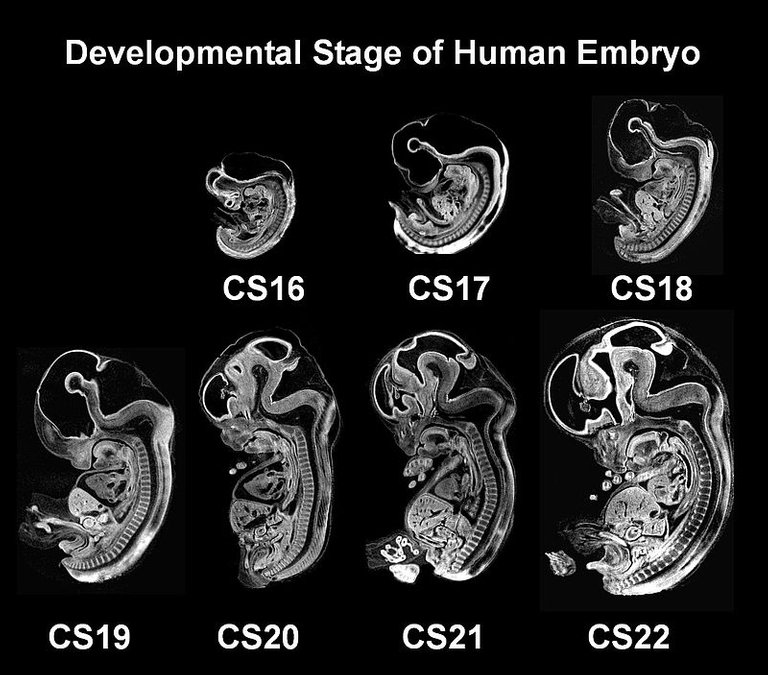
Magnetic Resonance Microscopy of the human embryo at different developmental stages
Also,o note that one of the most important qualities possessed by teratogenic agents is their ability to cross the placenta from the maternal circulation and enter the fetal circulation. Provided an agent is unable to cross the placenta into the fetal blood, it cannot cause any harm to a developing embryo. This is why women are always advised to be mindful of what they are exposed to and what they ingest as drugs or food during pregnancy (especially in the first half weeks).
All the human organs are not formed at the same time, they all have different periods at which they are formed, so it is even advisable to abstain from any substance or agent that might pose a threat to the baby during pregnancy.
Besides the ability to cross the placenta, some other qualities and factors that can determine if tokens would affect a developing fetus, as well as the severity of the effect include
•How susceptible the genes of both the child and the mother are to teratogens and other agents that can cause havoc.
•How long the woman and the fetus were exposed to the teratogen also plays a big role. The longer the exposure, the high chances of severe effects and harm.
•The nature of the teratogen also matters. A teratogen that is fast metabolized might have lesser time to exert its effects (This only holds for nonbiological agents).
•The period of exposure is also important. A baby that is exposed to a teratogenic substance at three to 16 weeks of gestation (prime period for brain development) would likely suffer mental retardation. Generally speaking, the first of pregnancy is the most vulnerable.
•The dose and potency of the teratogen (in this case drugs) is also a factor worth considering. A higher dose would result in severe negative effects on the fetus.
Carcinogens on the other hand are substances or agents that are capable of causing cancer in humans. They usually do this by causing a genetic mutation (change in the DNA sequence of a target gene) in the genes of the host. By carcinogens being able to cause mutation, they are referred to as mutagens Most times, changes in gene structure associated with carcinogens are passed down from one generation to another while that of teratogens may not always be.
For emphasis' sake, note that not all carcinogens cause cancer rather, they increase the chances of someone having cancer. The key difference between teratogens and carcinogens is that the former causes birth defects during child fetal development while the latter can cause cancer to be it during pregnancy or in maturity, it is not situational.
Once you hear teratogen, the first thought that should run through your mind is a birth defect. Also note that any damage during embryogenesis (embryo formation) is irreversible and unfortunately, teratogens are well known and notorious for this. I believe it is clearer now. Let's now go deeper and channel our focus more on teratogens. We will begin our discussion proper with the notorious teratogenic agent that led the wide awareness of teratogens, it is no other than the drug, Thalidomide
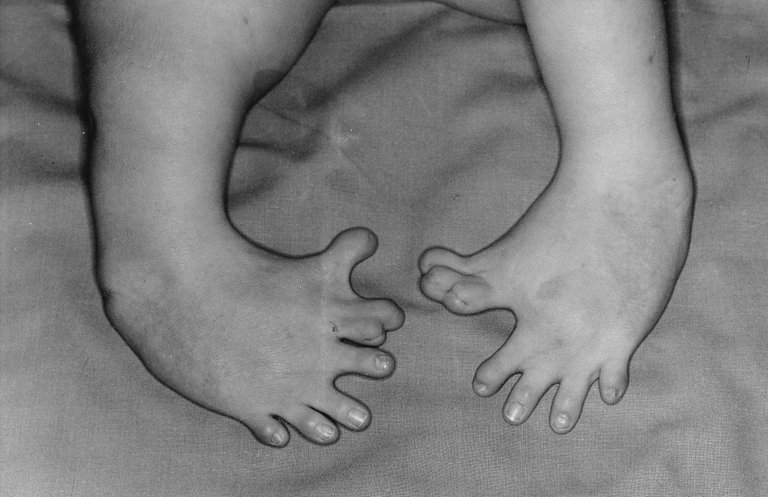
Congenital malformation in a baby born to a mother that used thalidomide
How it happened
One of the commonest ways through which people are exposed to teratogens is usually during pregnancy. The pain of childbirth and the quest to treat morning sickness (nausea and vomiting that occurs in women during pregnancy) in the early 1960s made some women use one of the well-known teratogens - Thalidomide.
Because of the multiple supposed therapeutic effects of the drug, it was serendipitously even used in the treatment of leprosy, colds, flu, and even multiple myeloma (a type of cancer that affects the plasma cells which produces antibodies and B cells).
The primary design of the drug was for use in childbirth as a tranquilizer (sedative), to reduce the pain of labor women have to pass through. In the long run, it turned out that after thousands of babies were born to women that took the drug, all were deformed, a really sad occurrence.
The nature of the congenital malformation that happened to all the thousands of children born then is called Phocomelia.
Phocomelia is a rare congenital defect defined by the absence of intermediate segments of the extremity. Children with phocomelia present with their hands or feet directly attached to the trunk. Phocomelia is famously a teratogenic side effect of the drug "thalidomide," a drug first marketed to treat anxiety and morning sickness
Just as we earlier noted, the effects of teratogens are mostly noticed after a high prevalence of the effects on babies. It happened that, thousands of babies had already been deformed as a consequence of the drug usage.
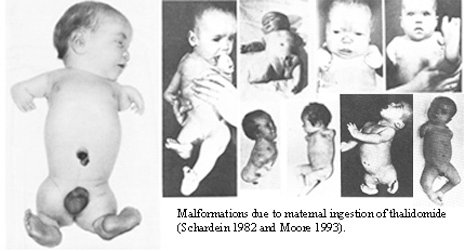
The thalidomide effects on newborns
Because of this incident, the drug was withdrawn from the market and expressly banned. Medicine after death.
Thalidomide is an orphan drug (a drug that is produced for the treatment of orphan disease condition - a rare medical that affects a lesser population of people and because pharmaceutical companies would not make enough profit by mass producing them, they are given incentives by the government to make them available), it was easier to wipe it off the market afterward, but the irreversible damage had already been done. A menace we will never forget.
Sometimes seeing some of those that were affected by these drugs defying odds by making impacts is an encouragement that, your situation should never be an excuse to attaining and accomplishing one's goals in life.
Are teratogens only drugs by nature?
Of course not, there are a host of other agents that have teratogenic effects just like thalidomide. Thalidomide drew more global attention because it had massive effects. Over time through research, more agents were discovered and they include drugs like phenobarbitone, Carbamazepine, Lamotrigine, Phenytoin, and valproate (for managing epileptic seizures and valproate has the highest teratogenic potential among all the antiepileptic drugs).
Even some antimicrobial drugs (the most abused drug class) have been implicated to have teratogenic effects. Two of the well-known are Tetracyclines and fluoroquinolones. These two sets of families must be avoided during pregnancy. They both can cause irreversible effects on the tissue and some organs like the ear of the child.
Medications for neurologic conditions are among the drugs with the highest teratogenic potential. One of the most commonly prescribed drug categories in pregnant women is antiepileptic drugs (AEDs), used primarily to prevent seizures, but also for neuropathic pain, migraines, and psychiatric disorders. AEDs in low doses can cause cognitive defects and, in higher doses, cause structural malformations.
Tetracycline for example is the cause of teeth discoloration in children. It changes the color of the teeth from natural white to Fluorescent yellow color. This drug can do this becomes it can freely pass through the placenta into the fetus circulation and also into tissues.
Bone is a tissue, hence the reason. Also, remember that one of the main characteristics of a teratogen is the ability to cross from the maternal circulation through the placenta into the fetal circulation. As much as possible, as a pregnant mum, avoid taking a substance that has not been confirmed safe during pregnancy. When using drugs, the lowest dose is always advised. Any malformation due to teratogens is for life.
Other besides drugs are biological infectious agents like syphilis, Herpes simplex virus, Rubella virus, Cytomegalovirus, and toxoplasma. Organic compounds containing mercury, polychlorinated biphenyl PCB, and herbicides are also implicated in causing teratogenic effects.
Infection with some of these biological pathogens has been proven to have a lifetime effect on the development of a fetus. Research has shown that infection with Cytomegalovirus for example results in a host of congenital defects in developing fetuses and even after birth.
An HCMV infection of the fetus in the first or second trimester can cause complex post-encephalitic impairment of the infant's brain, leading to motor and mental retardation, cerebral palsy, epilepsy, retinal defects, and progressive hearing loss.
Teratogens are around us, we just have to be aware of their presence and avoid them as much as possible. Let's delve further into some teratogens that are still ingested by people to date.
Making the case with the widely most ingested teratogens
It has been established through research that, the two widely causes of various congenital malformation or birth defects in children are smoking and alcohol. One of the reasons for this is that these two substances contain an addictive chemical that makes the users never get satisfied.
The case with alcohol and smoking is much more preventable because it is something that you can always avoid. It is not therapeutic but a habit learned thus, can always be unlearned. Why are alcohol and smoking in this picture?
Alcohol when consumed by a pregnant woman passes from her blood circulation into the fetal blood circulation. In essence, It can pass through the placenta into the baby's blood.
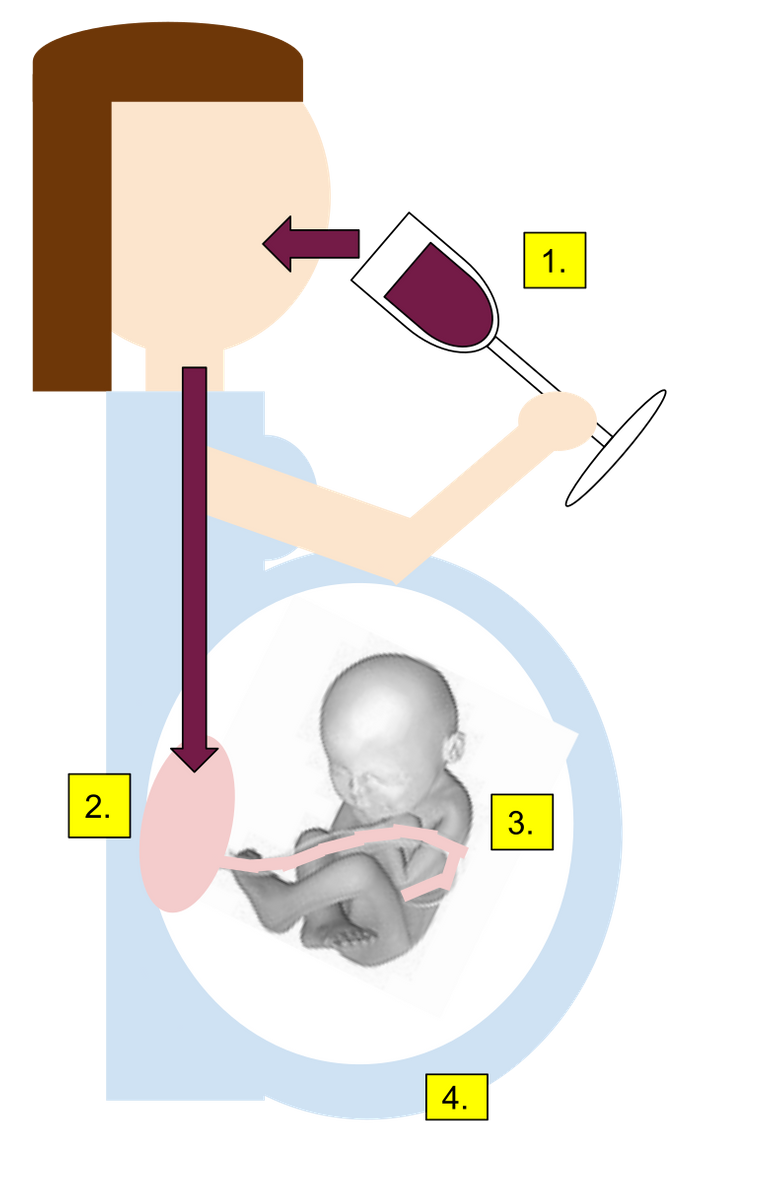
Maternal to fetal alcohol route leading to fetal alcohol syndrome
Alcohol is a substance whose metabolism varies among individuals because of the unique genetics of everyone. The way an individual's body system handles metabolic processes.
As humans, we are all genetically different. The way our body handles a drug differs. Ever wondered why someone can drink ten bottles or more of beer yet does not feel the effect immediately while another person, on taking just three bottles begins to manifest signs of excessive alcohol consumption.
It's not that the person that took the 10 bottles is too strong to be dealt with by the excess alcohol he took, rather, the reason is simple, his liver rate of catabolism of alcohol is extremely fast. You can read more about drug more about this post - Drug concepts I made over 4 years ago.
The difference in metabolism can be explained by the concept of pharmacogenomics (the study of how someone's genes affect the way they respond to or handle body handles drugs) and pharmacokinetics (how the body handles drugs and substances).
How it affects children
Alcohol
Organs like the liver are the major organ that is responsible for the metabolism of alcohol in adults. In developing fetuses, their liver is still yet to fully develop and as such, their rate of alcohol metabolism or breakdown is extremely low when compared to adults. As a result of the slow breakdown, a greater percentage of the alcohol in the fetus remains highly concentrated and unchanged over a long period.
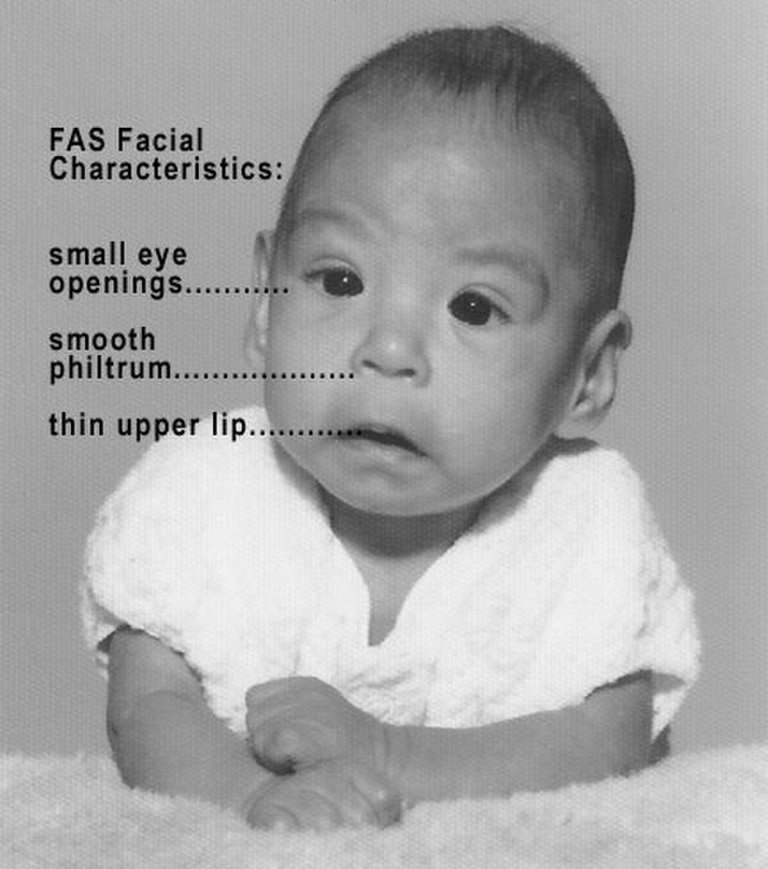
Baby with fetal alcohol syndrome
As the concentration of this alcohol remains high in the fetus, they block and affect the ability of the fetus to receive oxygen and nutrient supply from the mother. As a result of this, the fetus becomes malnourished, which also results in alcohol-induced reduced oxygen to the fetus.
Besides the malnourishment, some of the metabolites produced as a result of the breakdown in the pregnant mother also can pass through the placenta. The toxic effects of these metabolites and their effects also add up to the host of disorders associated with alcohol toxicity in the fetus. The broad effects of alcohol on the baby result in a widely known disorder.
Fetal alcohol spectrum disorder (FASD) describes developmental issues from high maternal alcohol intake, which commonly results in fetal growth restriction and long term morbidity.
The constellation of birth defects associated with the prenatal exposure of the fetus, that is, a high concentration of alcohol in the fetus results in a condition known as Fetal alcohol spectrum Disorder/syndrome. This disorder is the most common nongenetic disorder that causes mental retardation in children.
Funny enough, the birth can occur even within 3-4 weeks of pregnancy. In essence, it can occur even when the woman is unaware of her pregnancy. From this, it's obvious that the best time to eve stop taking alcohol is before pregnancy.
Smoking
Smoking is another good source of teratogens. A pregnant mother who is a smoker is prone to give birth to low-weight babies, preterm birth (giving birth to mature babies), and birth defects associated with the mouth and the lips.
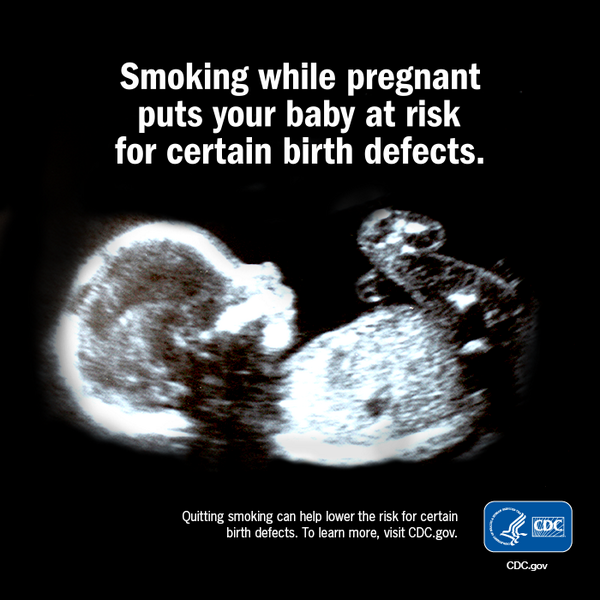
Effects of smoking during pregnancy
Smoking even goes as far as causing brain and tissue damage in the fetus's brain and lungs. The carbon monoxide from cigarettes as well as the toxic chemicals content of tobacco smoke also seriously harms the developing fetus.
Similar to the effects of alcohol, carbon dioxide competes with oxygen. It is well known that carbon dioxide binds 250 times more to hemoglobin than does oxygen. In essence, they displace oxygen from binding to hemoglobin thus, prevents oxygen transport to the developing fetus.
According to the report from CDC,
One in every five babies born to mothers who smoke during pregnancy has low birth weight. Mothers who are exposed to secondhand smoke while pregnant are more likely to have lower birth weight babies. Babies born too small or too early are not as healthy as those born on the term. CDC
One thing about babies born prematurely is that they are at higher risk of having serious health challenges such as mental retardation, cerebral palsy, miscarriage, congenital heart problem, Ectopic pregnancy (wrong implantation of the fused zygote formed after fertilization outside an area other than the uterus), placental abruption (separation of the placenta from the uterus before childbirth), lifetime deformation and even they may die.
In conclusion, most of these birth defects are not inherited and as such, prevention is the keyway. Never use drugs unsupervised or recommended. The effects they have most times see for life and the chances of correcting them are slim.
As a pregnant mother, abstain from smoking and taking alcohol. Remember, what you drink, your child drinks as well. Some drugs are small enough to pass through the placental barrier into the baby to cause damage to vital organs and disrupt the normal cellular differentiation of cells and tissues.
Remember also that the most critical stage of any child's development is embryogenesis. Whatever drugs you take be sure, it is recommended and the dosage is well calculated and proven not to have any effect on the developing fetus.
References
•Smoking in pregnancy: effects on mother and fetus
•CDC - Smoking & Tobacco Use
•Carcinogens and Teratogens
•Phocomelia
•Teratogens
•Designating an Orphan Product: Drugs and Biological Products
•Teratogenic Medications
•Tetracycline in pregnancy?
•Effects of Pregnancy and Nutritional Status on Alcohol Metabolism
•Detrimental Effects of Ethanol and Its Metabolite Acetaldehyde, on First Trimester Human Placental Cell Turnover and Function
•Primary Human Cytomegalovirus (HCMV) Infection in Pregnancy

